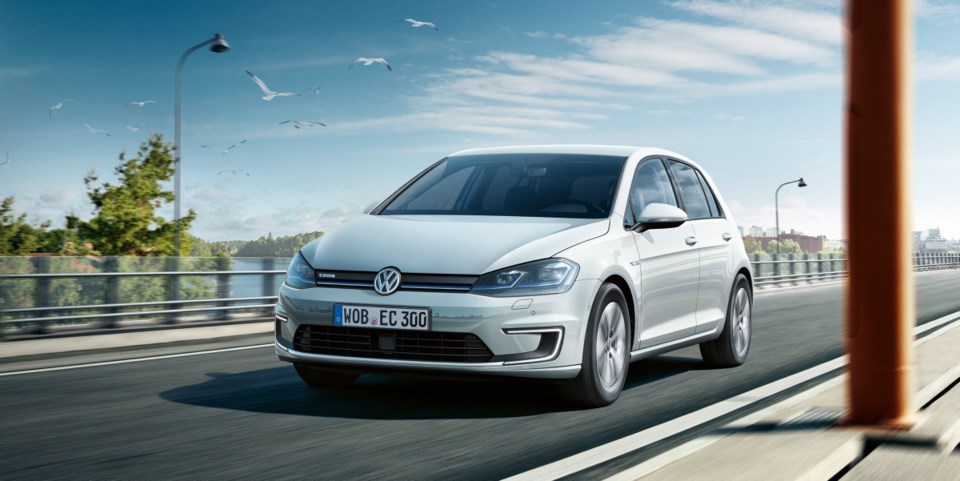Volkswagen has quietly introduced the 2018 e-Golf — the “e” signifying that it is the long-awaited electric-powered version of the popular Golf — its first all-electric vehicle in Canada.
The hope is that the e-Golf will one day replace the diesel as the go-to powerplant for those who seek the ultimate fuel efficiency and low emissions.
The e-Golf comes in only one trim level, the Comfortline, at $35,995.
Volkswagen has chosen to offer its first EV almost incognito. On the outside, there is not much differentiating the e-Golf from its gasoline-powered brethren — that is, if you are not particular about the colour.
If, on the other hand, you have a hankering for a particular shade, the e-Golf may just be your ticket, because you can choose from 40 standard and custom colours.
But there is a catch — that Ginster Yellow that you lust after will set you back a cool $2,995.
Colour aside, you can identify the e-Golf by the slightly revised grille and unique alloy wheels. The rest of the body panels are the same as the millions of Golfs found around the world.
A peek under the hood reveals a 100 kW Synchronous AC permanent-magnet electric motor, producing 134 hp and 214 lb.-ft. of torque. Volkswagen says the e-Golf can make the 0-100 km/h dash in 9.6 seconds with a top speed of 150 km/h.
Depending on their mood, the driver can choose between three driving modes — Normal, Eco and Eco+. In the latter, the car feels like there is an anchor attached to its rear. Stop at a light and the even the fan speed on the climate control system kicks down to save energy.
As in every BEV, there is a one-speed automatic transmission. In addition to putting the car in Park or Drive, the gearshift lever can also be used to increase regenerative braking by merely slapping the lever to the left. There are three levels of regenerative braking to choose from.
You can, with practice, slow the car without using your brakes and recharge the battery at the same time.
With a 35.8-kWh lithium-ion battery, the e-Golf has a range of just over 200 kilometres, according to Natural Resources Canada.
While the powertrain is all-new, the chassis and suspension remains relatively untouched. This is good news to the legions of dyed-in-the-wool VW fans, as the e-Golf inherits all the excellent handling traits of the regular Golf.
This makes the e-Golf perhaps the most entertaining BEV in the market, and certainly head and shoulders above others in its segment.
My tester came with the optional Technology Package, with a large 9.2-inch infotainment screen (the regular model comes with an 8.0-inch screen) with gesture control and satellite navigation. Given the emphasis on fuel efficiency, the car now rates your driving with real-time energy usage (both driving and using accessories that consume energy, such as the fan and heater). This allows you to turn off a fan, or accelerate more gently, and see the difference it makes to energy consumption.
Blind-spot detection, rear-traffic alert, lane assist and autonomous emergency braking with pedestrian monitoring are features only available in a slightly more expensive package.
It takes between four to five hours to charge the e-Golf using a 240-volt, 7.2-kW in-home charger. It is possible to use a supplied 120-volt charger plugged into a home plug, but it can take up to 26 hours to replenish a battery from empty. It can also accept a charge from DC Fast Charging Stations.
The interior of the e-Golf is pretty much the same as in other Golfs — understated, functional with a level of fit and finish honed over decades of refinement.
The five-door hatchback configuration offers ample cargo capacity: 341 litres with the rear seats up and 1,231 with the 60/40 split-back seats folded. The Golf carries four in comfort and five in a squeeze.
Competitors in the segment include the second-generation 2018 Nissan Leaf (out soon), the market-changing Chevrolet Bolt (reviewed last month), Ford Focus Electric, the Kia Soul EV and the diminutive Smart Fortwo ED.
While there are some that offer greater range, more power or are less expensive, the e-Golf is arguably the most fun to drive. Keep in mind that while it might not excel in any one category, it is very good in a number of areas.
Be aware that it might be a challenge to find one to test-drive at Canadian Volkswagen dealerships due to low inventory for this recently introduced model.
THE SPEC SHEET
Type: Compact battery-electric Vehicle, front engine, front-wheel-drive
Electric motor: 100 kW Synchronous AC permanent magnet, 134 hp and 214 lb.-ft. of torque
Battery (kWh): 35.8
Battery composition: Lithium-ion
Range (km): 201
Transmission: One speed automatic
Dimensions (mm): Length, 4,270; width, 1,799; height, 1,452; wheelbase, 2,629
Curb weight (kg): 1,567
Price (base/as tested): $36,355/ $40,405 (includes $1,645 freight and PDI and $100 AC tax)
Rebate on BEV (in B.C.): - $5,000
Options: Technology package $2,305
Tires: 205/55 R16
Fuel type: Electricity
Fuel economy (Le/100km): 1.9 city/ 2.1 highway
Fuel economy (kWh/100km): 16.8 city/ 18.6 highway
Warranty: Four years/80,000 km new car, five years/100,000 km powertrain
Note: This story has been corrected to say that the 2018 VW e-Golf can accept a charge from DC Fast Charging stations. A previous version contained incorrect information.



